What Do Chickens Eat?
May 21, 2020July 12, 2019 by C.B. Daniels
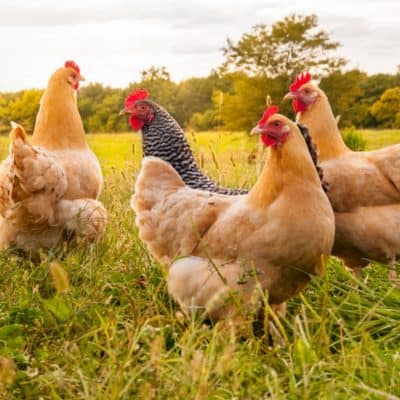
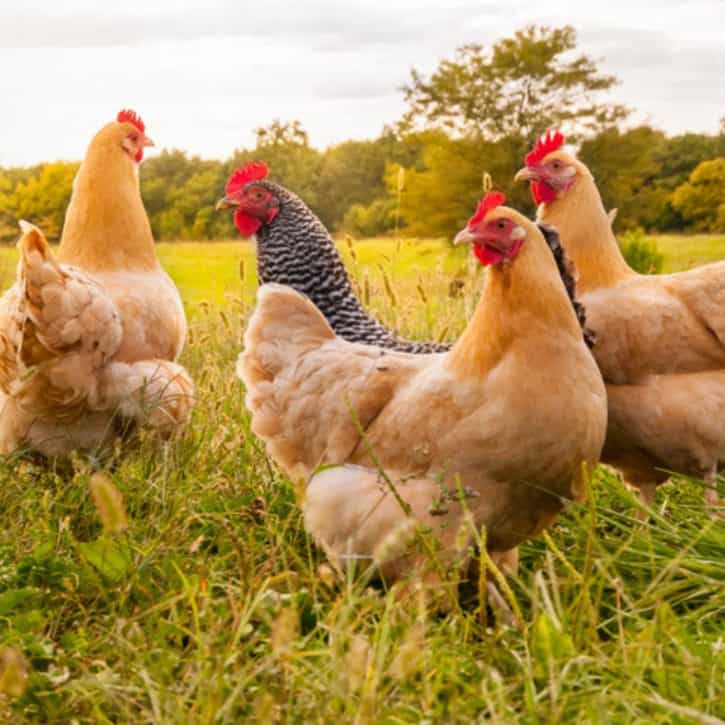
The Short Answer: Chickens will eat just about anything, but they should be primarily eating layer feed that is supplemented with oyster shells for calcium, grit for digestion, and treats. Some common supplemental treats are seeds, meats, vegetables, herbs, flowers, fruits, and scratch feed.
To find out more about chickens and what they eat, read on.
Contents
2.1 How Do Chickens Get Their Food?
2.2 What Do Baby Chickens (Chicks) Eat?
2.3 What Do Adult Chickens Eat?
2.5 Foods You Should NOT Feed Chickens
3 How Often Should You Feed Chickens?
5 Other articles you might enjoy
What Are Chickens?
Now that we’ve gotten the short answer to “What do chickens eat?” out of the way let’s take a closer look at chickens and their diets.
Chickens are domesticated birds from the family Phasianidae, which also includes turkeys, pheasants, and peacocks. They are typically kept as a source of food for both their meat and eggs, but also occasionally just as pets.
Chickens are a subspecies of the red junglefowl, which is a tropical bird that was domesticated in Asia. Since they originated from domesticated birds, there are no real “wild” chickens. However, there are feral chickens, which are domesticated chickens that have returned to the wild.
Chickens are incredibly widespread and can be found all over the world (we’re talking billions of chickens here). In fact, there are more chickens in the world than any other bird species.
Chickens even outnumber humans roughly 4 to 1. That’s a lot of chickens!
In the wild, feral chickens can live to be about 3-4 years old, and domesticated chickens can live to be about 7-8 years old if well-cared for.
Fun Fact: The oldest chicken, according to Guinness World Records was named Muffy, and she died at age 22 in 2011.
What Do Chickens Eat?
Chickens are omnivores, which means that they eat both plants and meat.
Chickens are not picky eaters and will eat just about anything. This includes things that are bad for them, such as toxic plants, moldy food, and even non-food items like Styrofoam.
Since most chickens that are kept are female, the primary food that chickens need to eat is layer feed. It has all the nutrients required for laying eggs such as calcium and protein. Hence, its name.
Even roosters are fed layer feed because it is not harmful to them.
Layer feed should also be supplemented with oyster shells (which can be bought whole, chopped, or in supplement form) to ensure that the hens are getting enough calcium. However, the shells should never be mixed into the layer feed, because that much calcium is harmful for roosters.
Instead, oyster shells should be supplemented separately from layer feed so that only the hens eat it.
Layer feed is typically found at farming supply stores such as Tractor Supply but can also be found at some pet supply stores such as PetSmart and Petco.
How Do Chickens Get Their Food?
Chickens are foragers, which means they travel to look for their food instead of hunting or ambushing prey.
Since they are domesticated, they don’t have to travel far, though.
Instead, humans provide their food for them, and they spend their day looking around for supplemental food.
Fun Fact: Chickens don’t have teeth!
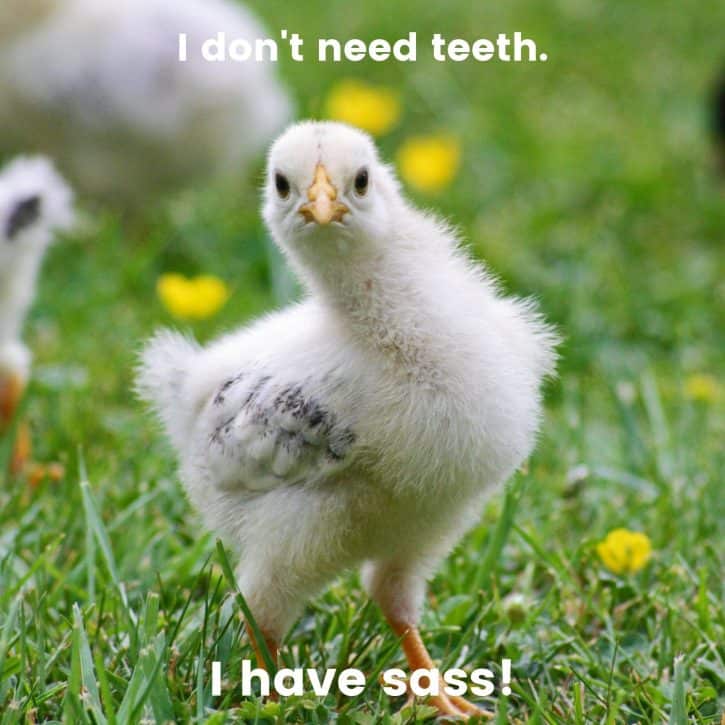
Since they don’t have teeth, chickens eat by pecking with their beaks. The food is then moistened by their saliva and pushed down their throats by their tongues.
This lack of teeth is why chickens need grit, which is tiny rocks, sand, shells, or coarse dirt that helps them to grind and break down their food for digestion.
While foraging chickens naturally pick up and swallow grit which is then stored in their gizzards (the muscular, thick-walled pouch that is the second part of their stomach).
The grit then grinds up their food for digestion. After the grit has been worn down over time to be small and smooth enough to pass, the chickens excrete the grit.
Grit plays a vital role in chicken’s health.
Without grit, food is too large to pass, and this can lead to blockage, which can be deadly. Also, without enough grit, food is not digested properly and can putrefy, which can make chickens very ill.
Free range chickens can typically get enough grit on their own, but not always.
Also, most commercial foods that are marketed for caged chicken production are purposefully small grained for easier digestion.
However, if chickens eat any other food beside commercial foods (such as vegetables, fruits, and meats), then they need grit in their diet.
Grit is very affordable, and a little bit goes a long way so just follow the adage: “when in doubt, put it out.”
There are two main types of grit available commercially: insoluble grit (also called flint grit) and soluble grit (also called oyster shell grit).
Flint grit- is grit that is typically made up of small pieces of flint or granite. It is insoluble (meaning it doesn’t dissolve in the gut) and must be passed.
Oyster shell grit- is grit that is typically made up of oyster shells, Cockle shells, or limestone. It is soluble (meaning it dissolves in the gut) and does not need to be passed.
Even though both types are labeled as grit (and they might seem interchangeable), they are not.
Flint grit is primarily meant for digestion, and oyster shell grit is primarily meant for providing calcium.
You can even buy mixes that contain the two mixed together but remember that roosters should not be feed oyster shells because that is too much calcium for them.
What Do Baby Chickens (Chicks) Eat?
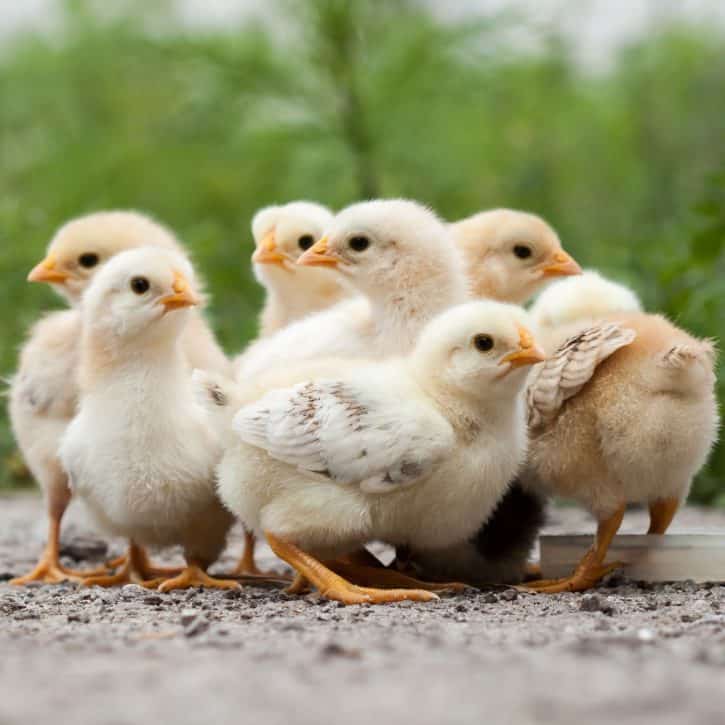
Baby chickens are called chicks and have a different diet than adult chickens do.
When chicks first hatch, they live off the yolk that they absorbed from their egg for the first two days of their life.
After two days, the chicks can be started on starter feed (also known as chick crumbs) until they are about 8-10 weeks old. Starter feed is much smaller than layer feed so that the chicks can eat it easier and has a different nutritional composition (mainly higher protein and lower calcium).
It is important not to feed chicks layer feed, because it is too low in protein for growing chicks and too high in calcium since they cannot lay eggs yet.
There are two types of chick feed: medicated chick feed and unmedicated chick feed.
Medicated chick feed- is, wait for it, chick feed that is medicated. It contains amprolium which is used to help prevent the disease coccidiosis, which can be deadly to chicks.
Medicated chick feed is typically fed to chicks in large production facilities that are prone to disease.
It is important to note that if your chicks have been vaccinated for coccidiosis, then you should not feed them medicated chick feed because it will cancel out their vaccination.
Unmedicated chick feed- is, wait for it, chick feed that is unmedicated. It does not contain any medications.
Unmedicated chick feed is recommended if your chicks have already been vaccinated or if you are feeding backyard chickens (and you feel that your yard is clean and disease free).
After the chicks are 8-10 weeks old, you have two options.
The first is that you can switch them over to grower feed, which is specifically designed to make them grow and gain weight. This type of feed also sometimes contains antibiotics.
Grower feed is typically used by people who are trying to grow chickens for specifically for meat eating (and not egg laying).
The second option is that you keep them on the starter feed and do not switch to grower feed. Many people feel that grower feed is unhealthy and unnecessary for egg laying chickens.
Starter feed is typically used by people who are raising chickens for eggs or free-range/antibiotic-free chickens for meat.
Regardless of which option you choose, after the chicks are 18-20 weeks old (this stage is called the “point of lay”), they can then be switched over to layer feed. Depending on the size and species some chicks may reach the point of lay earlier or later (larger chickens tend to be later than smaller chickens).
A good rule of thumb is to start your chick on adult layer feed once they have laid their first egg.
Fun Fact: Female chickens are called pullets until they are old enough to lay eggs (then they are called hens). Male chickens are called cockerels, cocks, or roosters.
What Do Adult Chickens Eat?
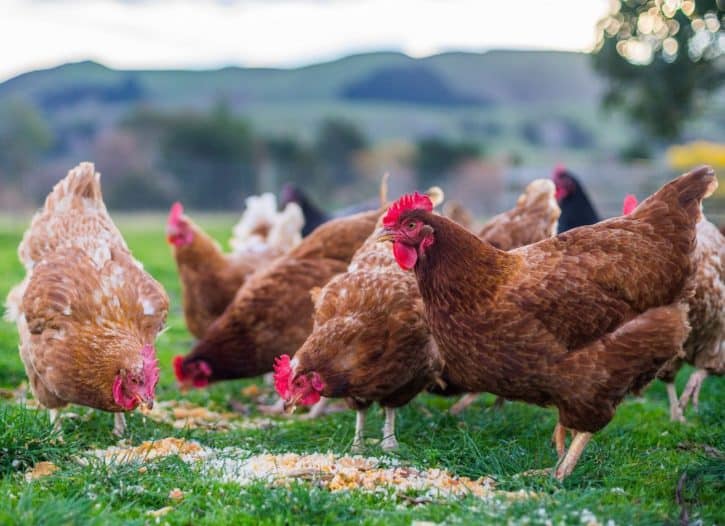
As mentioned previously, adult chickens should be eating layer feed that is supplemented with oyster shells for calcium, grit for digestion, and treats because life isn’t worth living without treats!
Remember to provide the oyster shells separately from the feed. The roosters will instinctively not eat it.
There are three main types of layer feed: mash, crumble, and pellets.
Mash layer feed- is an unprocessed and looser variety of layer feed. It is the finest ground version of the feeds and is easier to digest, but often wastes a lot of feed due to its texture.
Crumble layer feed- is a semi-loose and coarser variety of layer feed. It is firmer than mash but crumblier than pellets.
Pellets layer feed- is a hard and compact variety of layer feed. Because of its shape, it is often easier to store and won’t go to waste if it is accidentally knocked over by chickens. It is probably the most common of the three types due to its ease of use.
All three types have their own benefits, and they all also have high amounts of calcium to promote healthy egg laying.
Chickens should primarily eat layer feed, and it should make up 90% of their diet.
We already mentioned how chickens need oyster shells for calcium (which can be bought whole, chopped, or in supplement form) and grit for digestion (which comes in two main forms).
Now let’s look at the treats you can be supplementing your chickens’ diet with.
Technically, chickens could live off layer feed, but what’s life without some variety and dessert!
Here are some common supplemental treat categories: insects, seeds, meats, vegetables, herbs, flowers, fruits, and scratch feed.
Free-range chickens often find these items on their own (they spend most of their day searching for food). But non-free-range chickens should be fed these items by their owners.
While chickens can eat the above categories of treats, there are some key points to keep in mind:
- You should always chop up any treats so that they are easier for chickens to digest.
- You should never feed chickens uncooked beans.
- You should limit fatty, sugary, and salty foods.
- Any meat that is fed to chickens should have the excess fat removed and should be cooked.
Also, there is some debate over feeding your chickens table scraps.
Many people feel that this is a great way to treat your chickens while also limiting waste. However, some people feel that while chickens will eat anything, that they shouldn’t eat human food.
Fun Fact: It is illegal to feed chickens table scraps in the UK.

Chickens should be fed treats in the evening after they have eaten their layer feed so that they get all their required nutrients first, and (as with any treat) they should be limited.
Treats should make up no more than 10% of chickens’ diets, and they should be given no more than they can eat within 20 minutes.
The reason treats should be limited is because foods that are high in sugar, salt, and fat can make chickens overweight, and they will lay oversized eggs.
While this may initially seem like a good thing, it can cause egg binding, which is not only painful but often lethal as well.
Egg binding or having an egg-bound hen is when the egg is either too large or odd-shaped, and it becomes trapped in the oviduct.
When hens are trying to pass an egg, their cloaca (which is their cavity that passes both excrement and eggs) closes. This is to make sure the egg doesn’t become covered in excrement.
However, if the chicken cannot pass the egg due to its size, the cloaca remains shut. This means the hen cannot poop, and after around 24-48 hours, the hen will die.
Fun Fact: Chickens, like most birds, only reproduce using their left ovary. Their right ovary is typically non-functioning (it doesn’t mature after the chicken hatches).
Chicken Food Options
Here are some food options to treat your chickens with:
- Almonds
- Apples (without the seeds)
- Asparagus
- Bananas
- Beef (cooked)
- Bell peppers (but not the leaves, stems, or flowers)
- Blackberries
- Blueberries
- Bread (not moldy)
- Broccoli
- Cabbage
- Cantaloupes
- Carrots
- Cat food (yes, really)
- Celery
- Cereals (non-sugary ones)
- Cherries
- Chicken (cooked-although this seems weird!)
- Cooked beans
- Cooked eggs (giving them raw eggs often encourages them to eat their own eggs)
- Corn
- Crickets
- Cucumbers
- Dog food (also, yes, really)
- Fish (cooked)
- Grapes
- Kale
- Kiwis
- Leafy Greens
- Lettuce
- Mealworms
- Oatmeal
- Oats
- Peaches (without the pits)
- Pears
- Peas
- Pecans
- Plums
- Popcorn
- Pumpkins
- Pumpkin seeds
- Radishes
- Raisins
- Raspberries
- Scratch feed (a mixture of various seeds and grains like corn, oats, barley, and wheat)
- Seeds
- Shrimp (cooked)
- Spinach
- Squash
- Strawberries
- Sunflower seeds
- Tomatoes (but not the stems, leaves, or flowers)
- Walnuts
- Watermelons
- Wheat
- Zucchini
Foods You Should NOT Feed Chickens
Here are some foods you should NOT feed your chickens:
- Acorns
- Avocado (technically the flesh is fine, but not the pits and the skin)
- Chocolate
- Citrus fruits (not toxic, but often cause egg production to drop, and most chickens do not like to eat citrus fruits)
- Coffee
- Dates
- Eggplant
- Garlic (not toxic, but many people say it can affect the taste of the egg produced)
- Green potato skins
- Green tomatoes
- Onions
- Peanuts
- Pinto beans
- Rhubarb
- Soybeans
- Tuna
- Uncooked beans
How Often Should You Feed Chickens?
Since chickens are foragers, they like to eat small meals throughout the day.
It is recommended that you have feed out and available all day for your chickens.
However, for some people, this is just not possible. Many people often feed their chickens twice a day instead (once in the morning and once in the evening).
Weather also impacts how much you should feed your chickens.
Chickens often eat more in the winter months when they need more fat on their bodies.
Also, their foraging is limited in the winter, so you will need to provide them with enough food to offset what they would have naturally found on their own in the summer (if they are free-range chickens).
A great way to ensure that there is enough food is to use a “free choice” chicken feeder (also called a gravity feeder or range feeder) which stores the feed and distributes it as it’s eaten up. This also helps prevent the food from getting wet or having a lot of pests.
You can also just hand feed and put the food on the ground for them as well.
Thankfully, most chickens do not overeat and will stop when they are full (most obesity in chickens is caused by human food or too many treats given when they are hungry).
However, you should always have more than one feeder if you have over six hens, and feeders should be spaced apart from one another to prevent bullying.
Sadly, bullying in chickens is a common issue, and it is more prevalent in the winter when the chickens are bored.
Since pet chickens can bore easily, their owners are encouraged to hide their food so that they must look for it. This not only keeps them busy but encourages exercise as well.
A popular treat is pumpkins because chickens can peck at them for hours on end.
Because chickens do not eat at nighttime, you should always try to cover or take up any leftover food before bedtime. This will reduce pests, such as mice and raccoons.
Chickens also need continuous all-day access to clean water (although sometimes they seem to prefer muddy puddles).
Water is imperative for chickens. They can go up to two days without food but will die without water within a day.
Fun Fact: Chickens can run at speeds of up to 9 mph for short bursts.
Summary

Chickens will eat just about anything, but they should be primarily eating layer feed that is supplemented with oyster shells for calcium, grit for digestion, and treats.
Some common supplemental treats are seeds, meats, vegetables, herbs, flowers, fruits, and scratch feed.
Since most chickens that are kept are female, the primary food that chickens need to eat is layer feed. It has all the nutrients required for laying eggs such as calcium and protein. Even roosters can eat it.
There are three main types of layer feed: mash, crumble, and pellets.
Chickens should eat mainly layer feed, and it should make up 90% of their diet.
Layer feed should also be supplemented with oyster shells (which can be bought whole, chopped, or in supplement form) to ensure that the hens are getting enough calcium.
Never mix oyster shells with layer feed because it’s bad for roosters.
Chickens also need grit for digestion, which is tiny rocks, sand, shells, or coarse dirt that helps them to grind and break down their food for digestion.
There are two main types of grit available commercially: insoluble grit (also called flint grit) and soluble grit (also called oyster shell grit).
It is recommended that you have feed out and available all day for your chickens as well as clean water.
You can also supplement your chickens’ diets with treats.
Treats should make up no more than 10% of chickens’ diets, and they should be given no more than they can eat within 20 minutes.
Too many treats can lead to obesity and large eggs, which in turn can lead to egg binding and potentially be fatal.
You should NEVER feed chickens: acorns, avocados, chocolate, citrus fruits, coffee, dates, eggplant, garlic, green potato skins, green tomatoes, onions, peanuts, pinto beans, rhubarb, soybeans, tuna, or uncooked beans.
Some Reminders Regarding Treats:
- You should always chop up any treats so that they are easier for chickens to digest.
- You should never feed chickens uncooked beans.
- You should limit fatty, sugary, and salty foods.
- Any meat that is fed to chickens should have the excess fat removed and should be cooked.
Baby chickens are called chicks and have a different diet than adult chickens do.
When chicks first hatch, they live off the yolk that they absorbed from their egg for the first two days of their life. After two days, the chicks can be started on starter feed (also known as chick crumbs) until they are about 8-10 weeks old
Chick feed comes in two types: medicated chick feed and unmedicated chick feed.
It is important to note that if your chicks have been vaccinated for coccidiosis, then you should not feed them medicated chick feed because it will cancel out their vaccination.
After they are 8-10 weeks old you have two options: 1) you can switch them over to grower feed or 2) you can keep them on starter feed. After the chicks are 18-20 weeks old (this stage is called the “point of lay”) they can be switched to layer feed.
A good rule of thumb is to start your chick on adult layer feed once they have laid their first egg.
Other articles you might enjoy
Hi my name is C.B. Daniels and I make websites. I’ve also always been fascinated by animals. I thought that some of the information about animal diets and pet names was a little thin. So I figured I’d make this site to remedy that! I hope to make this site a hub for information about what animals eat, fun names you can use for your pets, and general animal information. Hopefully, you’ll find all the information about animals you are looking for and much more!
Latest posts by C.B. Daniels (see all)
- Can Rabbits Eat Grapes? - November 12, 2022
- Can Rabbits Eat Cucumbers? - November 3, 2022
- Can Rabbits Eat Spinach? - November 3, 2022